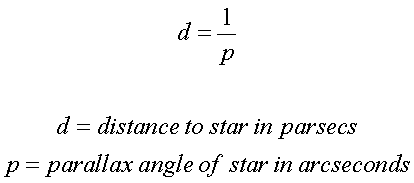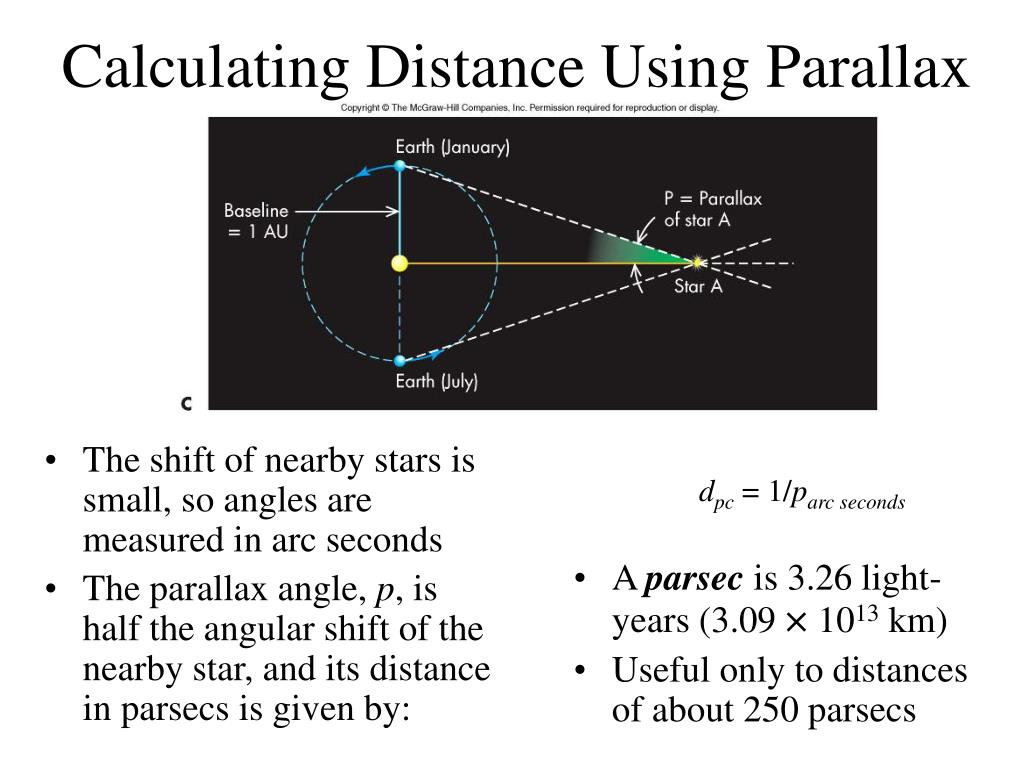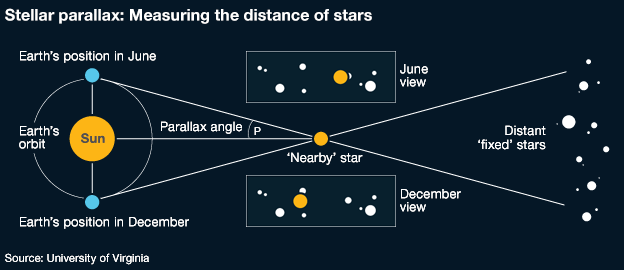

#p = (1"AU")/d#, or in other words, #d=(1"AU")/p#Īstronomical units are not the most convenient units to work with, though, so instead we define a parsec to be the distance to a star that shows #1# arc-second of parallax angle. To calculate the distance of a star using the stellar parallax method, proceed as follows: Find out the measured stellar parallax angle of the star. Since the star will be very far away, we can make the assumption that #tan p# is about equal to #p#. The units used to measure stellar distance are the light-year, the distance light travels in 1 year, and the parsec (pc), the distance of a star with a parallax. We can use #tan p# to find the distance to that star. In the image above, we can see that by cutting #alpha# in half, we get a right triangle where one leg is the distance between the sun and the other star. Stellar Parallax and Distances For nearby stars, distance is determined directly from parallax by using trigonometry and the size of Earths orbit. This is enough to get a noticeable angle, #alpha#, between the star's two apparent locations. This apparent motion (it is not 'true' motion) is called StellarParallax.

The Method of Trigonometric Parallaxes Nearby stars appear to move with respect to more distant background stars due to the motion ofthe Earth around the Sun. The distance d is measured in parsecs and the parallax angle p is measured in arc seconds. Answer: You resort to using GEOMETRY to nd the distance. One AU is the average distance from the Sun to the Earth. The stars apparent motion is called stellar parallax. If we made two observations of the same star on opposite sides of the Earth's orbit, we would have a separation of #2# astronomical units, or AU. In astronomy, the distances to other stars is too great to measure using two objects on the Earth's surface.
#Parsec distance using stellar parallax Pc#
This is true in astronomy as well, but on a much larger scale. The parsec (pc) is a fundamental distance unit in Astronomy A star with a parallax of 1 arcsecond has a distance of 1 parsec pc is equivalent to: 206,265 AU 3.26 Light years 3. The closer the object is, the more it appears to move relative to the background. If you look with just one eye, then the other, the object will appear to move against the background.īecause your eyes are separated by several centimeters, each eye has a different perspective of where the object is relative to the background. One way to understand parallax is to look at a nearby object and note its position against a wall. The European Hipparcos satellite, in orbit above the atmosphere and its blurring effects, can make measurements with much higher precision, allowing accurate distance determinations to about 1000 pc (3200 ly).Parallax is a method of using two points of observation to measure the distance to an object by observing how it appears to move against a background. In 1838, Friedrich Bessel calculated its parallax half-angle to be 0.314 arcsec. The ground‐based limit of parallax measurement accuracy is approximately 0.02 arc second, limiting determination of accurate distances to stars within 50 pc (160 ly). 1 distance (pc) - Give it a try: the first star to have its parallax measured was 61 Cygni. Therefore its distance is d = 1/0.76″ = 1.3 pc (4 ly). The nearest star, α Centauri, has a parallax angle of 0.76″. The parsec, therefore, is the distance to a star if the parallax angle is one second of arc, and the parallax relation becomes the much simpler formĪ more familiar unit of distance is the light‐year, the distance that light travels (c = 300,000 km/s) in a year (3.16 × 10 7 seconds) one parsec is the same as 3.26 light‐years.

By convention, astronomers have chosen to define a unit of distance, the parsec, equivalent to 206,264 AU. Study with Quizlet and memorize flashcards containing terms like How is stellar parallax used to measure distances to stars, What is a parsec, How many light years are equivalent to one parsec and more. The relationship between the parallax angle p″ (measured in seconds of arc) and the distance d is given by d = 206,264 AU/p″ for a parallax triangle with p″ = 1″, the distance to the star would correspond to 206,264 AU. Because even the nearest stars are extremely distant, the parallax triangle is long and skinny (see Figure 1). The trigonometric or stellar parallax angle equals one‐half the angle defined by a baseline that is the diameter of Earth's orbit.

astronomers commonly use parsecs to calculate interstellar distances using telescopes. 1 parsec is used in other units to convert an imperial unit to a light year of approximately 206,000 years. SETI-The Search for Extraterrestrial Intelligenceįor nearby stars, distance is determined directly from parallax by using trigonometry and the size of Earth's orbit. A parsec is defined as a distance from the observer of one second that is 1 arc longer than the observer’s position.Internal Structure Standard Solar Model.Interior Structure: Core, Mantle, Crust.Minor Objects: Asteroids, Comets, and More.Origin and Evolution of the Solar System.


 0 kommentar(er)
0 kommentar(er)
